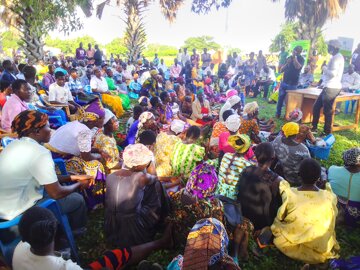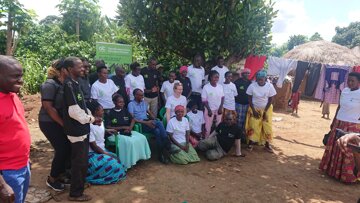"Thanks to G4AW, we know what works, and that enables new successes"

Boudewijn van Silfhout, director eLEAF
The Netherlands invested for ten years in the Geodata for Agriculture and Water (G4AW) program. In this series, key players look back and forward. Boudewijn van Silfhout, director of eLEAF, worked on an insurance for hundreds of thousands of farmers. 'With our products, we have helped an entire industry in Uganda.'
You were involved in various G4AW projects. What result stands out for you?
"I became director of eLEAF because I wanted to contribute to impactful solutions for the major societal challenges in our world. An important condition for impact is continuity: you have to come up with something sustainable that can exist not only as long as there is subsidy. That's why I'm most proud of the index insurance we worked on. With this, we improve the position of many smallholder food producers."
What is index insurance?
"Such insurance automatically pays out when the actual situation deviates from the expected situation. For example, you expect a certain amount of rainfall and evaporation. Those are the 'normal' conditions. Now, let's say, there is much less rainfall. Due to the drought, farmers' harvest will be less successful or even fail. An index insurance pays out for significant deviations from the long-term average of rainfall or evaporation, thereby compensating for the lower realized crop yield."
How do you make such insurance profitable?
"In remote areas, it's not feasible to send insurance inspectors to assess the damage or determine the loss in crop yield. That's very labor-intensive and therefore too expensive and difficult to scale up; smallholder food producers would never be able to afford the insurance premium. We use satellite data, supplemented with weather data, to calculate rainfall and evaporation in real-time. Compared to historical data, it can then be determined whether there is 'drought' or excessive rainfall. Precisely because we use rainfall and evaporation data automatically calculated based on satellite images, the insurance becomes affordable and scalable. So, we don't need continuous harvest data or other field data. When a predefined threshold of rainfall and evaporation is reached, there is drought, and the insurance pays out automatically. This has, of course, been extensively tested in practice, and we conduct regular quality tests."
The farmer doesn't need to provide evidence of a failed harvest?

©eLEAF
"That's correct. The data that comes from the model is accepted by the insurer as evidence. This keeps operational costs low and the premium affordable for the farmer. Sometimes the government bears part of the burden. For example, in Uganda by subsidizing the premium. At the end of the G4AW program, 186,000 farmers in Uganda had taken out insurance. That's serious impact.
Can you make that very concrete? What is that impact?
"No harvest means no money to buy new seeds or fertilizer. Or to pay your children's school fees. After a severe drought, it can take a small food producer up to seven years to fully recover. With index insurance, we accelerate the recovery of farmers. If you multiply this situation by a quarter of a million farmers, you see that such insurance provides protection to an entire industry."
Does the insurance only pay out for drought?
"We mainly focus on drought. This is straightforward to measure, it is common, and it has the greatest consequences for farmers. But we also provide insurance in the same way for excessive rainfall, for example. And we combine these risks and make them into one insurance product."
What obstacles did you encounter in developing index insurance?
"First of all, that smallholder food producers have little money. That's why government contributions play such an important role. Additionally, trust in the product is important. We have invested a lot in the professionalization of the entire chain, especially locally. We offer our products to local organizations, and they insure the end-users. So, you depend on those employees. What is their expertise? Are they well rewarded? Do they market the product correctly? And most importantly: what expectation do they create for the end-user?"
Why is the latter so important?
"If an intermediary says, 'All your damage will be compensated,' then he doesn't create the right expectation among the farmers. After all, a fixed amount is paid out in case of drought. That only covers a part of the damage. In the Netherlands, we sometimes face similar situations. The expectations of what you can achieve with Earth observation satellites can be too high. Take precision agriculture, for example. That's a promise of the last fifteen years. You can do incredible things with satellite data, that's true. But you shouldn't claim that it's easy and the solution to all problems because it's not. You have to seriously invest in the development of services and demonstrate the added value."
Index insurance is sometimes offered in combination with other products. Do you think this is a good idea?
"This is called bundling of services. For example, a seed supplier can sell index insurance with their seeds. That's certainly not a bad idea. Seed suppliers claim something about how drought-resistant the crops are. Then it's logical to give some kind of 'guarantee' in the form of drought insurance. And there's another important advantage. Index insurance products are not easy to explain and sell. Seeds, fertilizers, pesticides; everyone understands those. If you put them together in a package, the insurance reaches many more end-users."
Services based on satellite data are scalable, you mentioned. How did scaling up index insurance go?
"During the G4AW program, we reached over 180,000 farmers. Since then, tens of thousands of farmers have been added annually, also in other countries such as Togo and Mali. With what we have learned within G4AW, we have also improved and further developed our services. Currently, in Uganda, farmers still depend on local subsidies. In the future, we hope it can sustain itself without government subsidy."
The Netherlands government has invested a lot in G4AW, but the program is ending. What strategy could the government use to follow up on this?
"We have developed a lot of knowledge and technology for this program. We have sowed, you could say. Now you see the first shoots of harvest above the ground. What do you do then? Do you leave those shoots to the whims of nature? Or do you continue to care for them? Invest in them? Support from the Dutch government in further developing and introducing these services ensures that you achieve impact faster and more targeted. It reduces the financial risk for companies and covers the costs of (local) NGOs and farmer cooperatives that otherwise would not be funded. These organizations are often indispensable for introducing the services to farmers. G4AW has demonstrated that."

©eLEAF